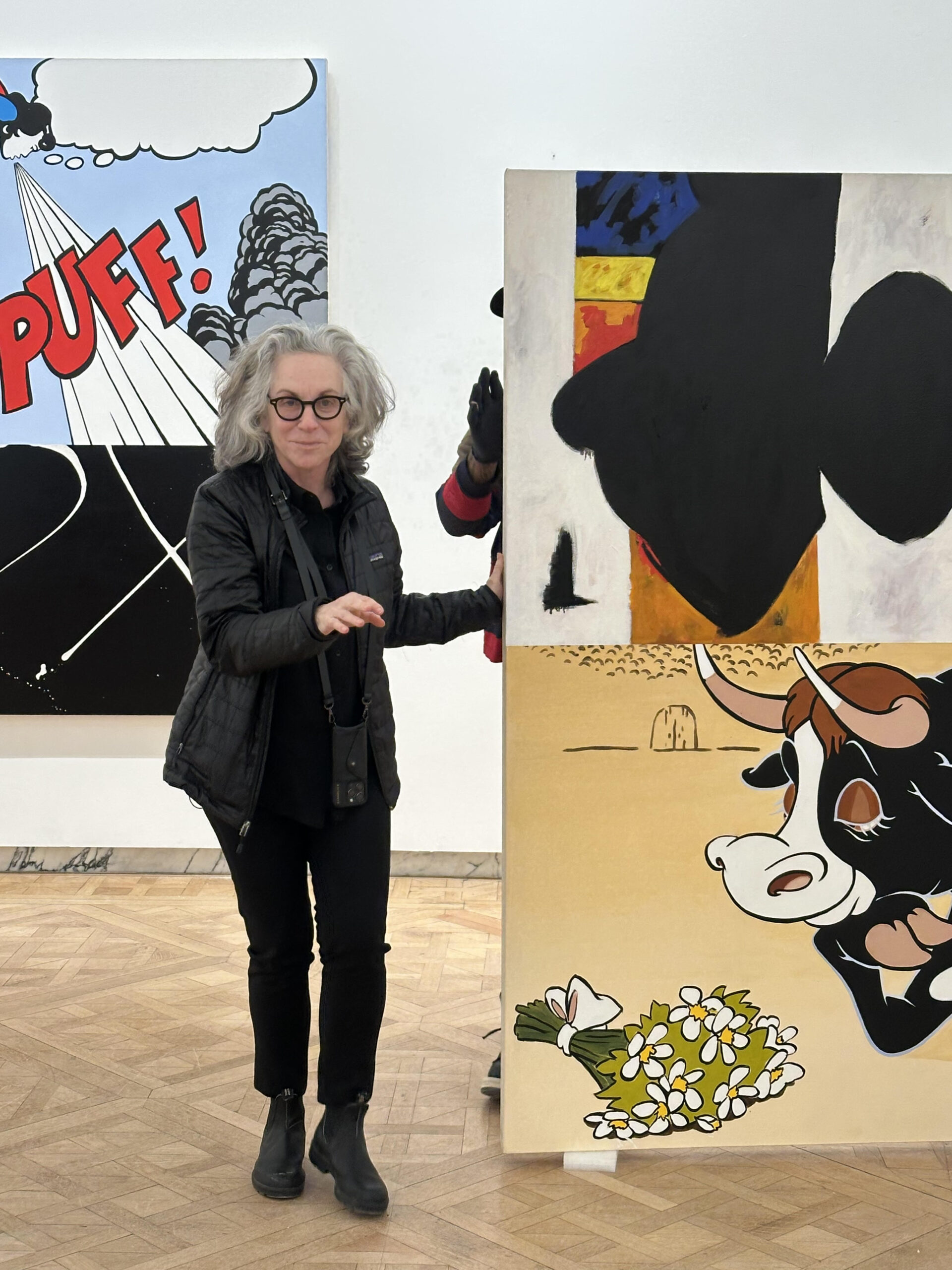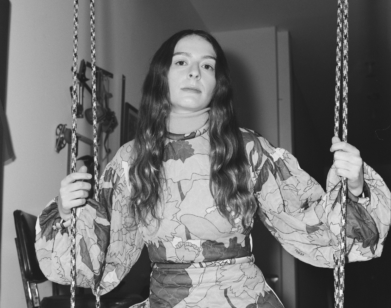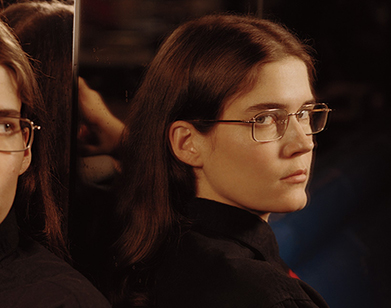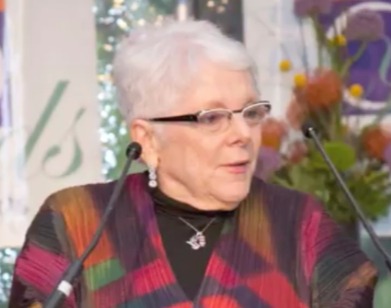RETROSPECTIVE
“I’m So Old Testament, Honey”: Deborah Kass, in Conversation With Titus Kaphar
For more than three decades, Deborah Kass has been using the language of the art market in order to deconstruct and subvert it. Her new exhibition, The Art History Paintings, now on view at Salon 94, comprises 12 works that were born out of the Reagan years, during which America’s middle class was squeezed and a new order of wealthy young white men who understood art as a bona fide asset emerged. Working as a queer Jewish woman, Kass rarely found a place in an industry careening rapidly toward commodification, so she spent her illustrious career challenging the conventions of an exclusionary market and reinterpreting its popular tropes and motifs. “I’d often go to the MoMA and the Met after school,” she told her friend and fellow artist Titus Kaphar last month. “I’d roam the galleries and I fell in love.” But these institutions, she continued, “are love letters to the white men who made it.” In conversation, Kass and Kaphar explored her career-long mission of disrupting the regime, the intense misogyny of the 1990s, and how they were first brought together by the poetry of Adrienne Rich.—EMILY SANDSTROM
———
DEBORAH KASS: Hi, darling.
TITUS KAPHAR: How are you doing?
KASS: I’m good. I just watched Shut Up and Paint an hour ago. I’d never seen it.
KAPHAR: You never saw it?
KASS: I don’t know why, but I never saw it. And I’m so glad I did before this conversation because so much of what you talk about is among the many, many things we have in common.
KAPHAR: All right, we should just jump in.
KASS: Jump in, baby.
KAPHAR: I wanted to know, for this body of work, what was the political moment that it emerged from?
KASS: The work came out of a decade of Ronald Reagan and Reaganomics, and how his tax policy shifted the burden from rich to the middle class, creating an enormous amount of new money and power in America. Income inequality—that was the beginning of it soaring. That was the most comprehensive attack on the middle class, ever. It was sort of the beginning of the art world and market as we know it now, because with all of this wealth creation, young white men with a lot of money were really interested in this new asset: art. And they had an entire generation of white male painters who were happy to supply that. And I arrived in New York in the middle of the 70s, when feminism and women had an enormous amount of power and the most interesting art was absolutely being made by women.

KAPHAR: Yeah. If I could find a through line for most of the work that you make, in these subtle ways and sometimes not-so-subtle ways, it really is about the disruption of power. And your work came into the world when there was a power and economic shift, but now we see that again in a much more extreme way, right? So, how do you feel about bringing this work back into the world at this point?
KASS: As I was planning for this show, we didn’t know who was going to win the election. So the environment it was going to come out again in was 50-50, up for grabs. And now we know.
KAPHAR: I have images of your work in front of me, and I went back to those images thinking of a different president. It speaks to what it means to be an engaged artist and recognize that the thing that you make inside of your private space exists as one thing, but once it gets out into the world, there’s a transformation that happens that you have zero control over. Right now I’m staring at My Spanish Spring. What’s the cow’s name?
KASS: That’s Ferdinand the Bull.
KAPHAR: I’m looking at that piece—that juxtaposition, that relationship. Obviously, the first visual relationship is just the palette, Motherwell’s palette and the palette of the bull. But it also seems like more of a juxtaposition of high art and a cartoon. Are you thinking about that at all in this piece?

My Spanish Spring, 1991-1992. Oil, acrylic, and flashe on canvas. 76 x 63 in. 193 x 160 cm.
KASS: It’s hard to remember, but in general, all this work is about disrupting visual regimes that reinforce sexism and racism, and white male supremacy. And the high-low thing, I guess this is generational—
KAPHAR: What do you mean by that?
KASS: It’s all information. In the digital age, we’re all getting scraped for information. What is this information telling us that we refuse to see, or that we could see if we weren’t so conditioned to not see? I would like to say it was a strategy, but it’s really not. It’s just how we live.
KAPHAR: I love this expression, “Disrupting the visual regime.” Can you talk about that a little bit? I want to get that tattooed on my shoulder.
KASS: Yeah, this work was about deconstructing white male power, white male value, white male history, white male language. So, how has the history of modernism or painting or art re-inscribed misogyny? What aren’t we seeing that’s right in front of our eyes?
KAPHAR: I remember we had a studio visit when I was at Yale really early on, and you quoted something to me. Do you remember what it was?
KASS: I will always remember what it was because it’s a quote that has been at the bottom of my practice since I read it in the 70s. It’s a poem by Adrienne Rich called “The Burning of Paper Instead of Children.” The quote I said to you when I walked in the door and raised my hand was, “This is the oppressor’s language, yet I needed to talk to you.”

Subject Matters, 1989-1990. Enamel, gold lead and acrylic on canvas. 63 x 135 inches. (160 x 342.9 cm).
KAPHAR: I’ll never forget that. It comes back to me a lot, actually. It’s been the thing that I have kept with me most out of school, and it’s part of the reason why we have the relationship we have. Can you speak about how that quote impacts this particular body of work?
KASS: Well, it’s almost a directive. It really is what the work is. I grew up in the New York suburbs, and I’d often go to the MoMA and the Met after school. I’d roam the galleries and I fell in love. But these are love letters to the white men who made it. This was when young artists were selling for enormous amounts of money for the first time at auction and retail. That was not the case until my generation of white guys. And to go back to the 70s and what happened with Reagan and the beginning of income inequality, these young guys with money on Wall Street wanted to see themselves represented. So suddenly all of those great women artists who really were doing historic work were completely out of the picture. There were galleries that had no women. Mary Boone Gallery, which represented so many of these guys, had none for a long time. Women’s paintings didn’t matter. And these paintings are a reaction to that, because some of us wanted to paint. We didn’t want to be photographers, but we took the lessons from the picture generation and wanted to talk about the culture and wanted to make art about the culture with that same deconstructive urge.
KAPHAR: I want to ask you about the rise of the Guerrilla Girls. Is that about the same time?
KASS: Well, I’m not sure because, Titus, I was not a Guerrilla Girl.
KAPHAR: I don’t believe you.
KASS: That’s fine. You’re not alone. But honestly, I really felt like my job was public. I was a very outspoken person and I couldn’t hide. And you’re probably going, “Oh yeah, she probably wasn’t.”
KAPHAR: You—quiet? What do you mean?

Untitled First World Third World, 1990. Oil and flashe on canvas. 45 x 105 inches. (114.3 x 266.7 cm).
KASS: [Laughs] So anyway, I think they started in 1986, and these paintings started in ’89, and we were all part of a reaction. And it certainly was present in feminist art history, literary criticism, critical race theory, gender stuff. We’re talking everybody from bell hooks to Griselda Pollock to Judith Butler. It was an incredibly exciting time of political, intellectual ferment. I’m doing a book about this work, and I’ve got all my reading lists out from when I taught at RISD. And it’s riveting, because it’s before things got dogmatic, when things were new. I’ve always said that critical race theory’s relationship to law is how I figured out my relationship to art history.
KAPHAR: Oh, say more.
KASS: It was looking at the structural racism within the law and taking it apart. And we’re talking 1989. I’m sure I was late, but as a white girl, as I was on it. And to me it was like, “Let’s look at art history and see how these things are structured and written in.”
KAPHAR: Because in some ways, art history is our law, right? It defines our norms.
KASS: It’s certainly our bible.
KAPHAR: But what is the bible if not a collection of laws?
KASS: You know what I always say? “Mine is a vengeful god.”
KAPHAR: Shit.
KASS: I’m so Old Testament, honey.
KAPHAR: Grace and mercy and forgiveness, remember? Oh, can we jump back to the poem for a second?
KASS: Please.
KAPHAR: “Power rarely remembers the source of its power.” When we talk about that poem, we ascribe ownership of that language to a group of people for the purpose of understanding this idea, right? But what is fascinating to me about that particular poem is that there is so much blood and labor that is the source of those people’s power that I don’t know that I can say that it actually belongs to them because I feel like a lot of us died for that power. So there is some necessity to reclaim it and say, “Fuck you, that’s mine. I own that shit. And I get to say and talk however the fuck I want to talk.” And that’s what this work is doing.

Emissions Control, 1989-1990. Oil, acrylic, flashe, and enamel on canvas. 60 x 133 1/2 inches. 152.4 x 339.1 cm.
KASS: I don’t know where I got this, but I copied this down: “If we learn anything from [Gilles] Deleuze and [Felix] Guattari’s exceptional A Thousand Plateaus: Capitalism and Schizophrenia, it should be that the dominant powers appropriated from us first.”
KAPHAR: That’s what I’m talking about. If we’re talking about Picasso, then we have to talk about some of the influences of Picasso.
KASS: It’s like the Romans took over cities and cultures and just incorporated it and that’s how they became an empire. That is capitalism.
KAPHAR: Yeah. What did Picasso say?
KASS: “Good artists borrow, great artists steal.”
KAPHAR: There you go. Y’all stole all that shit.
KASS: They stole everything and they steal everything. And now we’re in hyper capitalism, and it’s our language. And that’s what we’ve been saying: “It’s our language too. Let it speak for me.”
KAPHAR: Exactly. Well, let’s talk about that for a second. I’ve never been able to make something because somebody put money in front of me. I’ve stopped doing commissions except under very, very strict circumstances. I just don’t like questioning my own motivations in the process of making.
KASS: Well, you have a kind of situation that could lead to temptation. I’ve never had that situation.
KAPHAR: What does that mean?
KASS: It’s like I used to say—I’ve never had the opportunity to sell out.
KAPHAR: Tell me what you mean.
KASS: I made these paintings, and I got shit for them. I didn’t have a community backing me up. I didn’t have institutional support. I was very naive, a word you used in Shut Up and Paint, because I thought I was having a conversation with my peers and with history. But it was not appreciated by people who are invested in power because—
KAPHAR: Can we talk about some of the critiques?

Before And Happily Ever After, 1991. Oil and acrylic on canvas. 72 x 60 inches. (182.9 x 152.4 cm).
KASS: Sure. I got pretty trashed because people in power were not interested in being confronted or deconstructed or told there’s another way to be. 1990 was the first time I showed any of these. And then I showed two more a year later in a group show. I got very, very bad reviews in 1990. 1992 was kinder, I think, because there were two years more of the early 90s that became a sort of feminist moment. Me and some others were involved with the Women’s Action Coalition, WAC. It was H.W. Bush. So we had eight years of Reagan and four years of Bush. AIDS was not being addressed. Abortion was under attack, women were under attack, gay people were under attack. People of color were always under attack. And there was a huge groundswell of feminism that happened between ’90 and ’92 in a certain kind of way.
KAPHAR: So you feel like that community of people got the work in a way that they didn’t before?
KASS: Maybe, or maybe critics who were writing at the time got more sensitized to feminism and misogyny themselves, because it was pretty extreme then.
KAPHAR: I want to go back to this idea that you didn’t get the opportunity to sell out. You had every fucking opportunity to sell out. You don’t even see it as an opportunity because you made the decision every single day to go to the studio and make what the fuck you wanted to make. You very easily could have been like, “Okay, this is what they want from white ladies, so this is what I’m going to do.” Right? No, that’s not what you did. You have always been a disruptor.
KASS: Well, I appreciate what you can see as my integrity, but the fact is that nobody wanted what white ladies were making. So I spent decades without galleries and it wasn’t my choice. And there’s no question, I’ve always been a disruptor because it’s just my unfortunate personality. But understand, nobody wanted us.
KAPHAR: Well, that’s interesting because there’s definitely the thing that people want from Black artists right now.
KASS: I understand that, believe me.
KAPHAR: Yeah, and I think there were versions of it.
KASS: There were, but it was for men, hon. Let me put it this way: there was a reason the most critical art of the 80s was photography done by women, because there was no photo market then. But I wanted to paint. I wanted to talk to painters about the history of painting, but literally there were no women showing who painted in the 80s, almost none. There was one here and there, but we got really pushed aside. There were women who started in the early 70s. They’re the generation that inspired me. Elizabeth Murray and Howardena Pindell and–
KAPHAR: And Marilyn Minter.
KASS: And Pat Steir and Joan Snyder.

Read My Lips, 1990. Oil and acrylic on canvas. 72 x 60 inches. (182.9 x 152.4 cm).
KAPHAR: Well, there are a lot of Black feminists, artists and writers that have been influential to you and your philosophy and thinking. Who are some of the people at the forefront? During our studio visits, you made references to very different kinds of writing than what was happening in my other studio visits. And there was a diversity of writers and gender in your references that I found inspiring. And it just happens that on your desk right there you have some of those books. Why don’t you read some of those titles?
KASS: I have no memory, Titus. I’m blank.
KAPHAR: We’re talking 20 years ago.
KASS: Now I’m going back now to all my sources.
KAPHAR: Uh-oh, we’re on the go now.
KASS: What do we have here? Black Macho and the Myth of Superwoman and Invisibility Blues by Michele Wallace, who I adore.
KAPHAR: Yes.
KASS: Vision & Difference by Griselda Pollock. Angela Davis, Women, Race and Class.
KAPHAR: That’s a good one.
KASS: Absolutely essential. Believing Is Seeing, by Mary Anne Staniszewski. Then Sarah Lewis, her new book, The Unseen Truth. It’s about how you see what you want to, even though what’s in front of your eyes is telling you something different.
KAPHAR: Shout out to Sarah Lewis.
KASS: Patricia J. Williams, the most elegant, in my humble opinion. I’m not an expert on critical race theory, but this was my–

Portrait of the Artist as a Young Man, 1991. Oil, enamel and acrylic on canvas. 84 x 66 inches. (213.4 x 167.6 cm).
KAPHAR: The Alchemy of Race and Rights, yeah.
KASS: I love that. Anything by Michele Wallace, but particularly pertinent to me was an essay that I think was in in Out There: Marginalization and Contemporary Cultures, published by the New Museum. That and Rethinking Representation were like, the textbooks. For my work, talking about disruptors, Robert Colescott and Faith Ringgold were absolutely essential for me because–
KAPHAR: I was waiting for you to say Faith’s name. I know she was pretty important to you.
KASS: Totally. I’ll send you pictures of everything later.
KAPHAR: Send me a bibliography.




